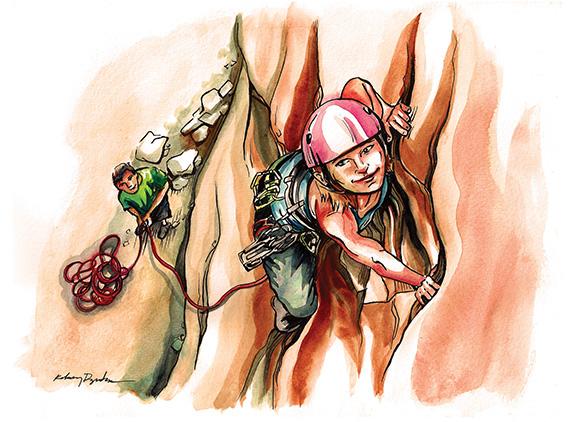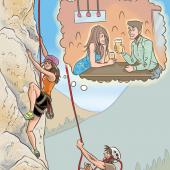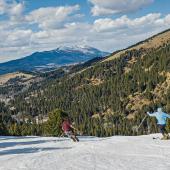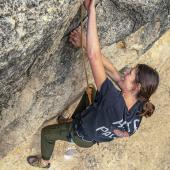Partners in Climb
Better belaying.
When looking for a partner, it’s tempting to consider someone with a nice-looking rack or a sweet set of nuts, but take it from me, you’re better off with a belay partner whose gear—and ego—is well-worn. There are too many people out there who claim to climb, but instead spend their time flaunting their equipment on social media, seeking partners who will shower them with thumbs-up approval. Despite the increasing number of d-bags around the crag these days, there are still some bona fide dirtbags: people who don’t need the newest Prana climbing pants, or the most aggressive shoes, or lavender-scented chalk. If you too want to rope up and cut the crap, but can’t figure out why your climbing days still consist of the auto-belay at Spire, here are some tips.
For starters, talk to people. Many Bozemanites have climbed before, so you’re not putting yourself out too much if you ask, “Do you climb?” If it’s a co-worker, a cutie in line at the Co-op, or a babe in Burke Park, be friendly and strike up a conversation about how great the conditions in Hyalite have been looking. If you both are up to climb, exchange numbers, and call if you say you’re going to. Agree on a time, and if you’re the one who initiated the date, let your partner know what to bring and what to expect.
When you call, have a plan. If you ask someone out for the first time, remember that “Want to go climb in Hyalite at 1am?” is similar to “Want to watch Netflix and chill?” It shows that you probably don’t have a plan, and that you and your partner might get into some very risky business.
Now, if you’ve never been to Practice Rock, tell the truth. Your partner will figure out soon enough if you were bullshitting about your Cardiac Arete lead. It’s okay for him to see that you don’t know everything—and just because you know some things, doesn’t mean you’re going to do all the work. Climbing is a team effort, and it will help your relationship if both you and your partner know that from the start.
After you do make a plan, show up. Be prepared and don’t expect your partner to bring water, snacks, or gear for you—unless he already told you he would. And it’s a safe practice to have extra water handy anyway, for when you and your partner get hot and bothered by the crux on Theoretically.
In addition, try to avoid talking about all the long and hard classics you’ve done. Even though you may want to tell your partner how experienced you are, there are other ways—communicate well, help him feel safe, and climb smart. It’s easy to blab about climbs you’ve done; it’s more difficult, and more fun, to climb.
When gearing up, if a more experienced partner says you didn’t follow through your knot, or that your harness isn’t double-backed, listen. His advice could save a life. A good belayer will help his partner become a better climber.
If a less experienced partner is ready to get onto the sharp end of the rope, encourage him, answer his questions, be an unselfish and attentive belayer—and don’t beta-spew. Even if your way is the “right way,” as long as your climber isn’t in any real danger, give him some real words of encouragement.
If you’re not cheering him on, embrace the silence. If you don’t know your partner well yet, get to know him, but not when you’re halfway up the route. From 50 feet up, “What did you say?” sounds a whole lot like “Off belay.” Be respectful of other climbers, be mindful of the timing and volume of your conversations, and welcome the quiet moments between you and your partner.
When we climb for ourselves and encourage others to do the same, seeking to become a better belayer rather than finding the perfect belayer, we will discover that they are all around us. And it just takes a few awkward moves, sweaty palms, and courage to get to the top of the world with one.











